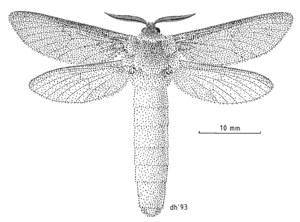Aoraia oreobolae facts for kids
Quick facts for kids Aoraia oreobolae |
|
|---|---|
 |
|
| Female | |
| Scientific classification |
The Aoraia oreobolae is a special kind of moth that belongs to the family Hepialidae. This moth is found only in New Zealand, which means it's endemic there. New Zealand's Department of Conservation has listed it as "At Risk, Naturally Uncommon." This means it's a rare species that needs our attention to stay safe.
Contents
Discovering the Aoraia oreobolae
This unique moth was first officially described by a scientist named John S. Dugdale in 1994. The very first specimen used to describe the species, called a holotype, was found in the Tapanui Blue Mountains in Southland. A person named N. Hudson collected it on March 8, 1987. Today, this important specimen is kept safe at the New Zealand Arthropod Collection.
What Does the Aoraia oreobolae Look Like?
The Aoraia oreobolae moth has a wingspan that varies depending on whether it's a male or a female. Male moths usually have a wingspan of about 52 to 56 millimeters (that's about 2 inches). Females are a bit smaller, with a wingspan of 39 to 55 millimeters.
Their front wings have a cool pattern that's ash-white mixed with dull dark brown. You can tell this moth apart from other Aoraia species because the males have long antennae (like feelers), and the females have full wings with thin, scattered scales.
Where Does the Aoraia oreobolae Live?
As we mentioned, the Aoraia oreobolae is endemic to New Zealand. This means it's not found anywhere else in the world! Specifically, these moths are only found in the Southland region of New Zealand.
Life and Habits of the Moth
Adult Aoraia oreobolae moths are usually seen flying around in March. This is when they are active and looking for mates.
Home and Food for the Aoraia oreobolae
The young moths, called larvae, eat a plant called Oreobolus pectinatus. These larvae live in special wet areas called cushion bogs in the Blue Mountains. These bogs are also home to the Oreobolus pectinatus plant, along with other plants like Gaimardea setacea and Dracophyllum muscoides.
Protecting the Aoraia oreobolae
The Aoraia oreobolae has a special conservation status in New Zealand. It's listed as "At Risk, Naturally Uncommon" under the New Zealand Threat Classification System. This means that while it's naturally rare, it's also considered at risk, and efforts are made to protect its habitat and ensure its survival.

